An Evaluation of National Park System Pilot Area Using the AHP-Delphi Approach: A Case Study of the Qianjiangyuan National Park System Pilot Area, China
Abstract
:1. Introduction
2. Materials and Methods
2.1. Study Area
2.2. Research Method
2.2.1. Delphi Method
2.2.2. Analytic Hierarchy Process (AHP) Method
- (1)
- Building a hierarchical model
- (2)
- Construction of judgment matrix
- (3)
- Consistency test
- (4)
- Evaluation category
3. Results and Discussion
3.1. The Evaluation Index System of National Park System Pilot Areas
3.2. Weights of the Items in the Evaluation Index System of National Park System Pilot Areas
3.2.1. The Weights of Items in the Criteria Level
3.2.2. The Weights of Items in the Indicator Level
3.2.3. The Weights of Items in the Factor Level
3.3. Comprehensive Evaluation of the Qianjiangyuan National Park System Pilot Area
3.3.1. The Analysis of the Scores of Items in Factor Level
3.3.2. The Analysis of the Scores of Items in the Indicator Level
| Objective Level | Score | Criteria Level | Weight | Score | Indicator Level | Weight | Score | Factor Level | Weight | Score |
|---|---|---|---|---|---|---|---|---|---|---|
| Comprehensive Evaluation of the Qianjiangyuan National Park System Pilot Area S | 90.801 | Natural resource condition A1 | 0.493 | 90.464 | Ecological condition B1 | 0.624 | 90.436 | Ecosystem representation C1 | 0.448 | 92 |
| Ecosystem Integrity C2 | 0.164 | 86 | ||||||||
| Ecosystem Authenticity C3 | 0.283 | 90 | ||||||||
| Biodiversity C4 | 0.106 | 91 | ||||||||
| Landscape value B2 | 0.28 | 91.25 | Natural landscape value C5 | 0.75 | 93 | |||||
| Human landscape value C6 | 0.25 | 86 | ||||||||
| Environmental attribute B3 | 0.096 | 88.355 | Area suitability C7 | 0.571 | 83 | |||||
| Soil quality C8 | 0.116 | 95 | ||||||||
| Hydrological quality C9 | 0.228 | 97 | ||||||||
| Climate quality C10 | 0.086 | 91 | ||||||||
| Research, education and recreation function A2 | 0.196 | 90.281 | Research function B4 | 0.25 | 93.69 | Scientific institutions C11 | 0.531 | 94 | ||
| Research Project C12 | 0.24 | 92 | ||||||||
| Research facility C13 | 0.085 | 96 | ||||||||
| Database building C14 | 0.144 | 94 | ||||||||
| Recreation and education function B5 | 0.75 | 89.145 | Completeness of interpretation/display facilities C15 | 0.381 | 90 | |||||
| Richness of educational display C16 | 0.243 | 93 | ||||||||
| Environmental capacity C17 | 0.064 | 89 | ||||||||
| Adequacy of recreational facilities C18 | 0.147 | 84 | ||||||||
| Destination accessibility C19 | 0.044 | 92 | ||||||||
| Recreation Product Richness C20 | 0.121 | 84 | ||||||||
| Management condition A3 | 0.311 | 91.666 | Management foundation B6 | 0.667 | 90.596 | Land tenure C21 | 0.059 | 96 | ||
| Natural resources property rights C22 | 0.092 | 84 | ||||||||
| Boundary range C23 | 0.041 | 94 | ||||||||
| Governing body C24 | 0.449 | 89 | ||||||||
| Management system C25 | 0.215 | 91 | ||||||||
| Managing financial security C26 | 0.144 | 96 | ||||||||
| Management Action B7 | 0.333 | 93.778 | Research monitoring capacity C27 | 0.298 | 97 | |||||
| Management equipment C28 | 0.089 | 96 | ||||||||
| Patrol enforcement C29 | 0.408 | 92 | ||||||||
| Community co-management C30 | 0.06 | 90 | ||||||||
| Public engagement C31 | 0.144 | 93 |
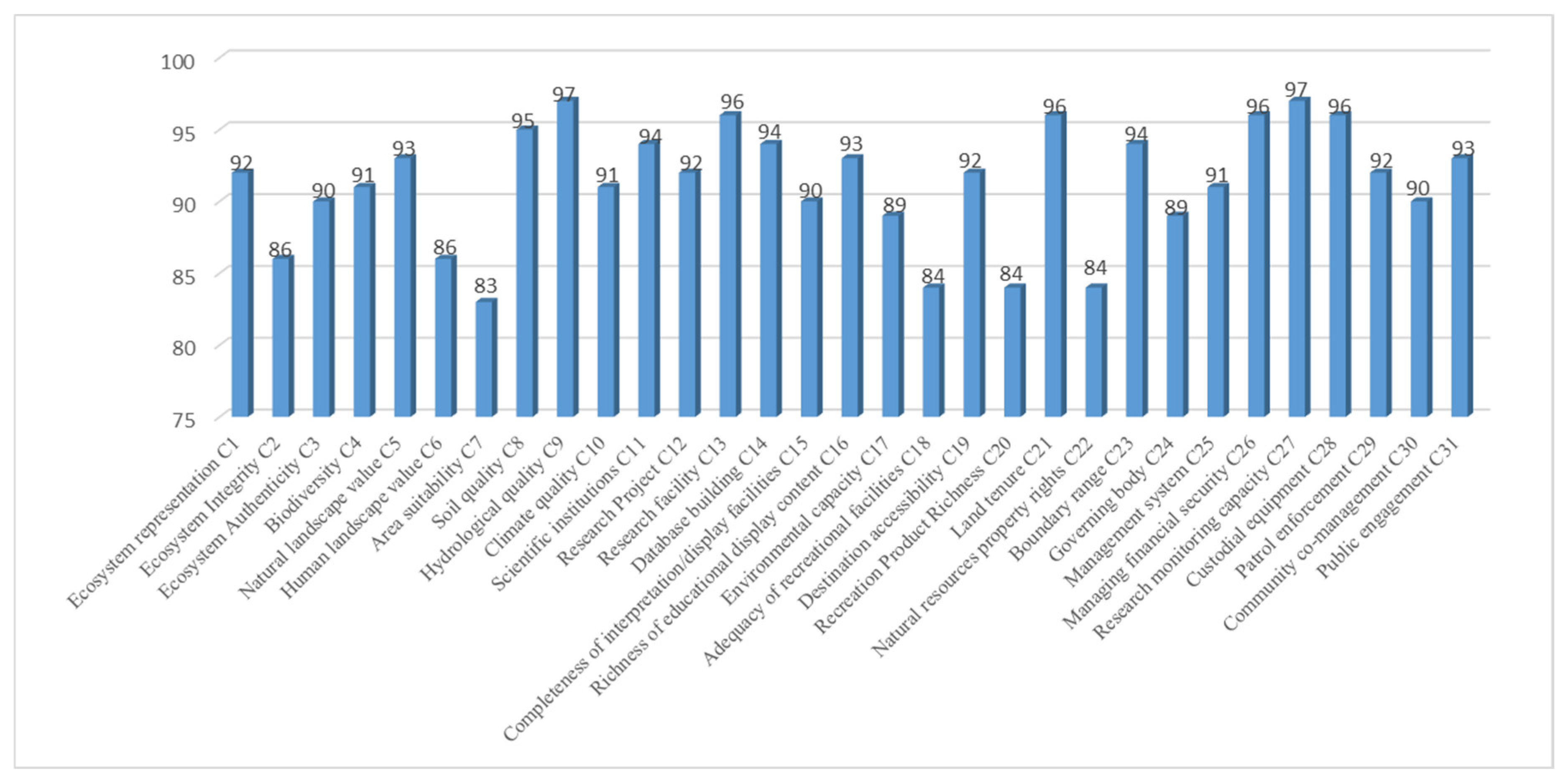
3.3.3. The Overall Evaluation of the QNPSPA
- (1)
- The area suitability score is low. The QNPSPA is the smallest among the 10 national park system pilot areas established by the government, with only 252 km2. It is also a densely populated area in eastern China, and there are many indigenous inhabitants within the boundaries of the national park, making it relatively difficult to ensure the suitability of its area and the integrity and authenticity of the ecosystem.
- (2)
- The low scores for the completeness of recreation facilities and the richness of recreation products indicate that the QNPSPA needs to improve its recreation functions. The QNPSPA originally consisted of the Gutianshan Nature Reserve, the Qianjiangyuan National Forest Park and the connecting part in between. The main function of the Gutianshan Nature Reserve is to protect the ecological environment, and few recreational facilities have been built in it. What’s more, the planned projects in the QNPSPA, including the science museum, botanical garden, museum and special park, have not yet been completed. Thus, the recreation facilities are not yet complete in the whole QNPSPA and the recreation experience is relatively homogeneous.
- (3)
- The score of natural resource property rights is low. Since nearly 80% of the forest land in the QNPSPA is collective forest land, it is relatively difficult to achieve the goal of ensuring that natural resource property rights are owned by all people, as mentioned in the Overall Plan for the Establishment of the National Park System [27]. At present, the proportion of natural resource assets owned by all people in the QNPSPA is 19.3%, which is far from ensuring that natural resource assets owned by all people take up the main position as required by the overall planning.
- (4)
- The human landscape value score is low. The QNPSPA is mainly characterised by low-altitude subtropical broadleaf evergreen forest ecosystems, and its historical and human attractions are relatively less well known.
- (5)
- Ecosystem integrity score is low. Due to the limited size of the pilot area and the relatively high population density, as well as its location at the border of three provinces, the parts of Anhui and Jiangxi provinces that are connected to the pilot area and within the pilot area still belong to one ecosystem, and cross-provincial cooperation is difficult to achieve unified and efficient conservation due to different administrative regions.
3.3.4. Recommendations for the QNPSPA
- (1)
- More cross-administrative cooperation and communication should be strengthened with the adjacent cities in Anhui and Jiangxi Province for overall conservation.
- (2)
- Improving the construction of recreational facilities and accelerating the important projects in the QNPSPA.
- (3)
- The beautiful countryside and rural revitalisation strategies should be combined to enhance the quality of the community environment and community improvement.
- (4)
- More research cooperation should be actively deepened as the highlights and characteristics.
- (5)
- It is necessary to strengthen management and conservation measures and strictly protect the ecological environment in this area, thus ensuring the integrity and authenticity of the ecosystem.
4. Conclusions
Author Contributions
Funding
Data Availability Statement
Acknowledgments
Conflicts of Interest
Appendix A
| Composite Indicator | Indicator | Indicator Type |
|---|---|---|
| Ecological condition | Ecosystem representative, Ecosystem typicality, Ecosystem authenticity, Ecosystem integrity, Biodiversity, Quantity of rare animals and plants | Natural resource |
| Landscape value | Natural landscape value, Human landscape value | Natural resource |
| Environmental attribute | Area suitability, Geological condition, Hydrological quality, Climate quality, Soil quality, Noise condition | Natural resource |
| Scientific and education function | Scientific institutions, Research project, Cooperation and communication condition, Research facility, Database building, Completeness of interpretation/display facilities, Richness of educational display content | Service Function |
| Recreation function | Environmental capacity, Adequacy of recreational facilities, Destination accessibility, Market potential, Completeness of infrastructure, Recreation product richness, Tourism revenue | Service Function |
| Management system | Land tenure, Natural resources property right, Boundary range, Governing institution, Management System, Managing financial security | Management condition |
| Management action | Research monitoring capacity, Patrol enforcement, Management equipment, Community co-management, Public engagement | Management condition |
| S | A1 | A2 | A3 | Wi |
|---|---|---|---|---|
| A1 | 1 | 2 | 2 | 0.493 |
| A2 | 1/2 | 1 | 1/2 | 0.196 |
| A3 | 1/2 | 2 | 1 | 0.311 |
| A1 | B1 | B2 | B3 | Wi |
|---|---|---|---|---|
| B1 | 1 | 3 | 5 | 0.624 |
| B2 | 1/3 | 1 | 4 | 0.280 |
| B3 | 1/5 | 1/4 | 1 | 0.096 |
| A2 | B4 | B5 | Wi |
|---|---|---|---|
| B4 | 1 | 1/3 | 0.250 |
| B5 | 3 | 1 | 0.750 |
| A3 | B6 | B7 | Wi |
|---|---|---|---|
| B6 | 1 | 2 | 0.667 |
| B7 | 1/2 | 1 | 0.333 |
| B1 | C1 | C2 | C3 | C4 | Wi |
|---|---|---|---|---|---|
| C1 | 1 | 3 | 2 | 3 | 0.448 |
| C2 | 1/3 | 1 | 1/2 | 2 | 0.164 |
| C3 | ½ | 2 | 1 | 3 | 0.282 |
| C4 | 1/3 | 1/2 | 1/3 | 1 | 0.106 |
| B2 | C5 | C6 | Wi |
|---|---|---|---|
| C5 | 1 | 3 | 0.750 |
| C6 | 1/3 | 1 | 0.250 |
| B3 | C7 | C8 | C9 | C10 | Wi |
|---|---|---|---|---|---|
| C7 | 1 | 5 | 3 | 6 | 0.571 |
| C8 | 1/5 | 1 | 1/3 | 2 | 0.116 |
| C9 | 1/3 | 3 | 1 | 2 | 0.227 |
| C10 | 1/6 | 1/2 | 1/2 | 1 | 0.086 |
| B4 | C11 | C12 | C13 | C14 | Wi |
|---|---|---|---|---|---|
| C11 | 1 | 3 | 5 | 4 | 0.531 |
| C12 | 1/3 | 1 | 2 | 3 | 0.240 |
| C13 | 1/5 | 1/2 | 1 | 1/3 | 0.085 |
| C14 | ¼ | 1/3 | 3 | 1 | 0.144 |
| B5 | C15 | C16 | C17 | C18 | C19 | C20 | Wi |
|---|---|---|---|---|---|---|---|
| C15 | 1 | 2 | 6 | 4 | 5 | 3 | 0.381 |
| C16 | 1/2 | 1 | 4 | 3 | 4 | 2 | 0.243 |
| C17 | 1/6 | 1/4 | 1 | 1/3 | 3 | 1/3 | 0.064 |
| C18 | 1/4 | 1/3 | 3 | 1 | 4 | 2 | 0.147 |
| C19 | 1/5 | 1/4 | 1/3 | 1/4 | 1 | 1/3 | 0.044 |
| C20 | 1/3 | 1/2 | 3 | 1/2 | 3 | 1 | 0.121 |
| B6 | C21 | C22 | C23 | C24 | C25 | C26 | Wi |
|---|---|---|---|---|---|---|---|
| C21 | 1 | 1/2 | 2 | 1/6 | 1/4 | 1/3 | 0.059 |
| C22 | 2 | 1 | 3 | 1/5 | 1/3 | 1/2 | 0.092 |
| C23 | 1/2 | 1/3 | 1 | 1/7 | 1/4 | 1/4 | 0.041 |
| C24 | 6 | 5 | 7 | 1 | 3 | 4 | 0.449 |
| C25 | 4 | 3 | 4 | 1/3 | 1 | 2 | 0.215 |
| C26 | 3 | 2 | 4 | 1/4 | 1/2 | 1 | 0.144 |
| B6 | C27 | C28 | C29 | C30 | C31 | Wi |
|---|---|---|---|---|---|---|
| C27 | 1 | 4 | 1/2 | 4 | 3 | 0.298 |
| C28 | ¼ | 1 | 1/4 | 2 | 1/2 | 0.089 |
| C29 | 2 | 4 | 1 | 5 | 3 | 0.408 |
| C30 | ¼ | 1/2 | 1/5 | 1 | 1/3 | 0.061 |
| C31 | 1/3 | 2 | 1/3 | 3 | 1 | 0.144 |
References
- Cao, H. The Significance Perspective and Modes of the Construction of National Park. J. Qinghai Norm. Univ. (Philos. Soc. Sci.) 2017, 39, 7–10. [Google Scholar]
- Wu, C.Z.; Liu, G. The Significance of the Construction of Chinese National Park. Tour. Trib. 2015, 30, 14–16. [Google Scholar]
- Alfred, R. The National Park Idea: Origins and Paradox of the American Experience. J. For. Hist. 1977, 21, 64–75. [Google Scholar] [CrossRef]
- Lee, E. Protected Areas, Country and Value: The Nature-Culture Tyranny of the IUCN’s Protected Area Guidelines for Indigenous Australians. Antipode 2016, 48, 355–374. [Google Scholar] [CrossRef]
- Tang, F. The Desired National Park in China. For. Constr. 2014, 5, 1–7. [Google Scholar]
- Hagen, D.; Evju, M.; Skovli, P.; Solli, S.; Erikstad, L.; Bartlett, J. From military training area to National Park over 20 years: Indicators for outcome evaluation in a large-scale restoration project in alpine Norway. J. Nat. Conserv. 2022, 66, 126125. [Google Scholar] [CrossRef]
- Li, C.; Yu, J.; Wu, W.; Hou, R.; Yang, Z.; Owens, J.R.; Gu, X.; Xiang, Z.; Qi, D. Evaluating the efficacy of zoning designations for national park management. Glob. Ecol. Conserv. 2021, 27, e01562. [Google Scholar] [CrossRef]
- Mwangi, F.; Zhang, Q.; Wang, H. International Journal of Geoheritage and Parks Development challenges and management strategies on the Kenyan National Park System: A case of Nairobi National Park. Int. J. Geoheritage Parks 2022, 10, 16–26. [Google Scholar] [CrossRef]
- Tadeu, M.; Nolasco, R.; Hanazaki, N. How do Brazilian National Park managers evaluate the relationship between conservation and public use? Environ. Sci. Policy 2022, 131, 1–9. [Google Scholar] [CrossRef]
- Minghu, L.; Yaquan, D.; Shufa, H.; Ya, L.; Kesan, L. A Study of National Park Selection Mechanism and Construction Standards in Chinac Based on Inspirations from Foreign Experiences. World For. Res. 2019, 32, 3–9. [Google Scholar]
- Yang, R. Thinking on the Six Characteristics of Chinese National Park System Construction. Environ. Prot. 2019, 47, 24–27. [Google Scholar] [CrossRef]
- Zheng, Q.; Shen, M. Mapping Knowledge Domain of National Park Management Research in China. J. Beijing For. Univ. (Soc. Sci.) 2020, 19, 55–61. [Google Scholar] [CrossRef]
- Dilsaver, L.M. America’s National Park System: The Critical Documents; Rowman & Littlefield Publishers: Washington, DC, USA, 2016. [Google Scholar]
- Goldingay, R.L. What Role Does Ecological Research Play in Managing Biodiversity in Protected Areas? Australia’ s Oldest National Park as a Case Study. Proc. Linn. Soc. New South Wales 2012, 134, 119–134. [Google Scholar]
- McNeely, J.A.; Miller, K.R. IUCN, National Parks, and Protected Areas: Priorities for Action. Environ. Conserv. 1983, 10, 13–21. [Google Scholar] [CrossRef] [Green Version]
- Borrini, G.; Dudley, N.; Jaeger, T.; Lassen, B.; Neema, P.; Phillips, A.; Sandwith, T. Governance of protected areas: From understanding to action. In Best Practice Protected Area Guidelines Series, 20th ed.; IUCN: Gland, Switzerland, 2014; xvi + 124. [Google Scholar]
- Chen, Y.; Chen, Y. The Ecological Views of National Parks—Case Studies of American National Parks. Chin. Landsc. Archit. 2016, 32, 57–61. [Google Scholar]
- State Council, C. General Plan for Establishing National Park System. 2017. Available online: http://www.gov.cn/zhengce/2017-09/26/content_5227713.htm (accessed on 24 May 2022).
- Chen, Y.; Huang, D.; Yan, S. Discussions on Public Welfare, State Dominance and Scientificity of National Park. Sci. Geogr. Sin. 2014, 34, 257–264. [Google Scholar]
- Duan, Y.; Zhao, X.; Zou, W.; Yan, Y.; Xu, D.; Ye, B.; He, Y. Evaluation on Wetland Ecosystem Service Value in Qianjiangyuan National Park Pilot Area. For. Econ. 2019, 4, 50–57. [Google Scholar] [CrossRef]
- Ma, B.; Zeng, W.; Xie, Y.; Wang, Z.; Hu, G.; Li, Q.; Cao, R. Science of the Total Environment Boundary delineation and grading functional zoning of Sanjiangyuan National Park based on biodiversity importance evaluations. Sci. Total Environ. 2022, 825, 154068. [Google Scholar] [CrossRef]
- Wubalem, A.; Tesfaw, G.; Dawit, Z.; Getahun, B.; Mekuria, T.; Jothimani, M. Comparison of statistical and analytical hierarchy process methods on flood susceptibility mapping: In a case study of the Lake Tana sub-basin in northwestern Ethiopia. Open Geosci. 2021, 13, 1668–1688. [Google Scholar] [CrossRef]
- Wu, C.Z.; Zhou, S.; Tao, C. Research for Adaptive Administration System of National Park Based on Ecosystem Management—Yellowstone National Park of America as an Example. Chin. Landsc. Archit. 2014, 30, 21–25. [Google Scholar]
- Zhang, Y.; Yang, R.; Zhao, Z. Preliminary Analysis on the Implementation Plans for the Chinese National Park Pilot Areas. Chin. Landsc. Archit. 2017, 33, 5–11. [Google Scholar]
- Li, S.; Sun, X.; Fang, Y.; Zhang, Y.; Cao, M. Evaluation of the spatial characteristics of farmer livelihood assets in the qianjiangyuan national park pilot. Biodivers. Sci. 2019, 27, 64–75. [Google Scholar] [CrossRef]
- Xu, D.; He, Y.; Zhao, X.; Ye, B. Adaptive governance of natural resources in Qianjiangyuan National Park. World Agric. 2019, 12, 36–43. [Google Scholar]
- Qianjiangyuan, N.P. The Introduction of Qianjiangyuan Nation Park. 2019. Available online: http://www.qjynp.gov.cn/news/detail.aspx?newsid=308 (accessed on 30 May 2022).
- Yu, W.; Chen, T.; Zhong, L.; Zhou, R. Functional zoning of the Qianjiangyuan National Park System Pilot Area. Resour. Sci. 2017, 39, 20–29. [Google Scholar]
- García-Melón, M.; Gómez-Navarro, T.; Acuña-Dutra, S. A combined ANP-delphi approach to evaluate sustainable tourism. Environ. Impact Assess. Rev. 2012, 34, 41–50. [Google Scholar] [CrossRef]
- Wang, Q.; Zhang, Y.; Yang, G. The Knowledge Mapping of China National Park Recation Utilization Research Based on the Citespace. Tour. Res. 2021, 13, 71–84. [Google Scholar] [CrossRef]
- Chen, L.; Ng, E.; Huang, S.C.; Fang, W.T. A self-evaluation system of quality planning for tourist attractions in Taiwan: An integrated AHP-Delphi approach from career professionals. Sustainability 2017, 9, 1751. [Google Scholar] [CrossRef] [Green Version]
- Saaty, T.L. A scaling method for priorities in hierarchical structures. J. Math. Psychol. 1977, 15, 234–281. [Google Scholar] [CrossRef]
- Martín-Fernández, S.; Gómez-Serrano, A.; Martínez-Falero, E.; Pascual, C. Comparison of AHP and a utility-based theory method for selected vertical and horizontal forest structure indicators in the sustainability assessment of forest management in the sierra de Guadarrama National Park, Madrid Region. Sustainability 2018, 10, 4101. [Google Scholar] [CrossRef] [Green Version]
- Pirdashti, M.; Omidi, M.; Pirdashti, H.; Hassim, M.H. An AHP-Delphi Multi-Criteria Decision Making Model with Application to Environmental Decision-Making. Iran. J. Chem. Eng. 2011, 8, 3–17. [Google Scholar]
- Park, S.; Im, J.; Jang, E.; Rhee, J.; Basin, P.R. Fuzzy AHP Integrated with GIS Analyses for Drought Risk Assessment: A Case Study from Upper. Agric. For. Meteorol. 2019, 216, 157–169. [Google Scholar] [CrossRef]
- Sari, D. A method to determine the potential for flora tourism in mountainous regions: A case study of the Kackar Mountains National Park, Turkey. J. Prot. Mt. Areas Res. Manag. 2019, 11, 27–35. [Google Scholar] [CrossRef]
- Sharma, L.K.; Kanga, S.; Nathawat, M.S.; Sinha, S. Fuzzy-AHP for Forest Fire Risk Modeling. Disaster Prev. Manag. 2012, 21, 160–171. [Google Scholar] [CrossRef]
- Bunruamkaew, K.; Murayama, Y. Site suitability evaluation for ecotourism using GIS & AHP: A case study of surat Thani Province, Thailand. Procedia Soc. Behav. Sci. 2011, 21, 269–278. [Google Scholar] [CrossRef] [Green Version]
- Nyongesa, K.W.; Vacik, H. Evaluating management strategies for Mount Kenya Forest Reserve and National Park to reduce fire danger and address interests of various stakeholders. Forests 2019, 10, 426. [Google Scholar] [CrossRef] [Green Version]
- Yang, R. Evolution And Experience of the National Park System of the United States. Chin. Landsc. Archit. 2001, 70, 62–64. [Google Scholar]
- Yu, J.; Wang, J.; Xiao, H.; Chen, X.; Chen, S.; Li, S.; Shen, X. Camera-trapping survey of mammalian and avian biodiversity in qianjiangyuan national park, zhejiang province. Biodivers. Sci. 2019, 27, 1339–1344. [Google Scholar] [CrossRef]

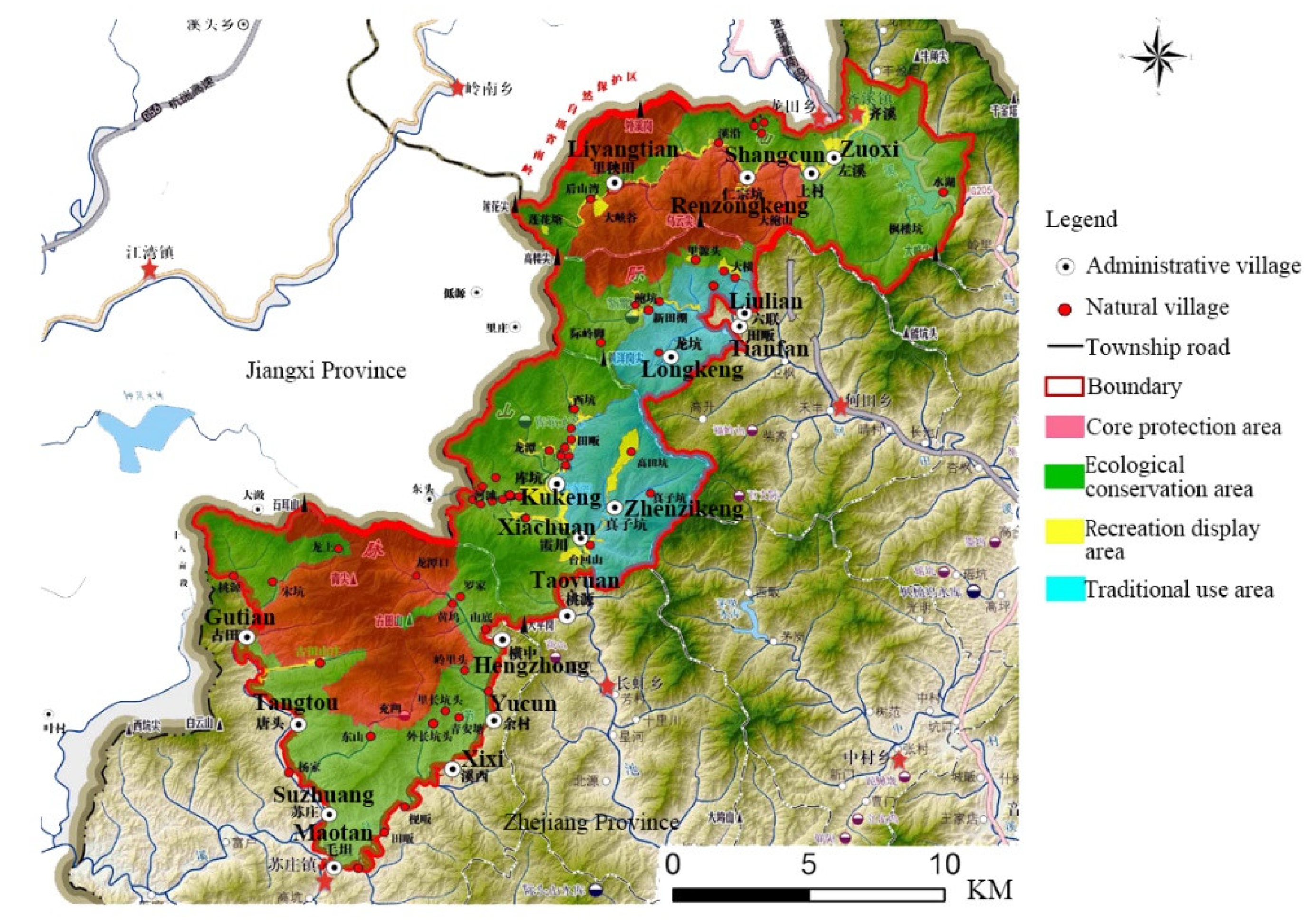
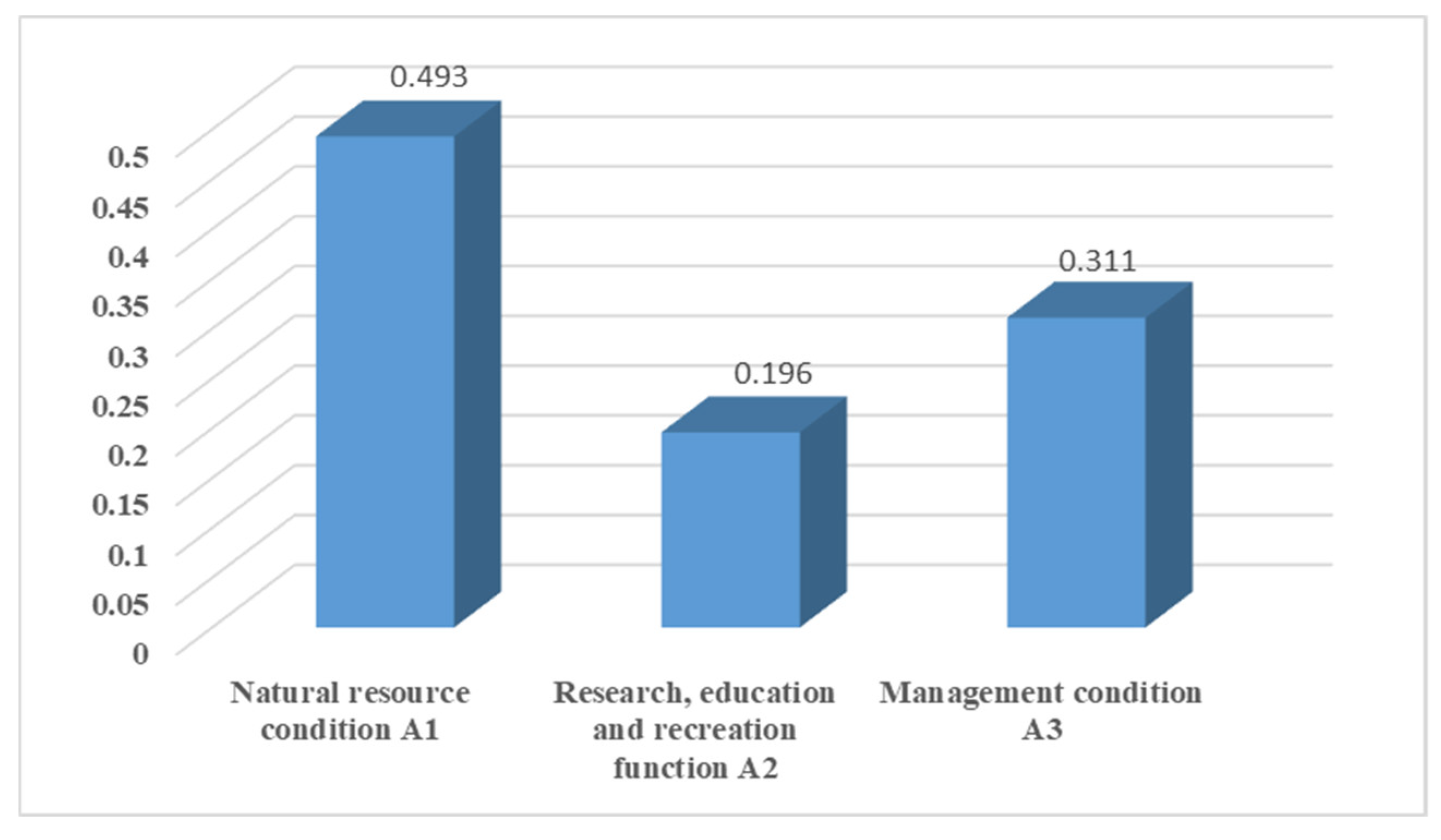
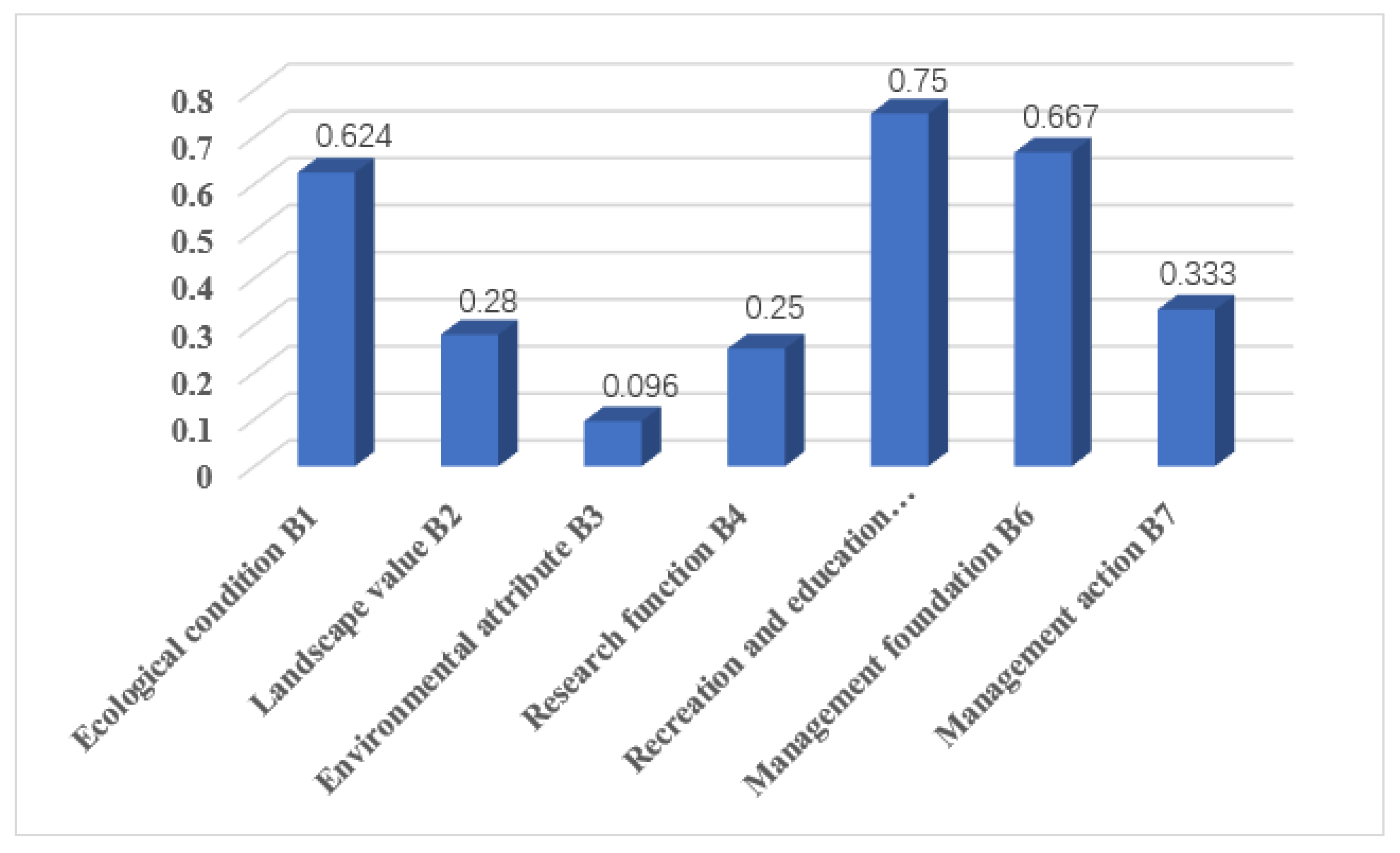
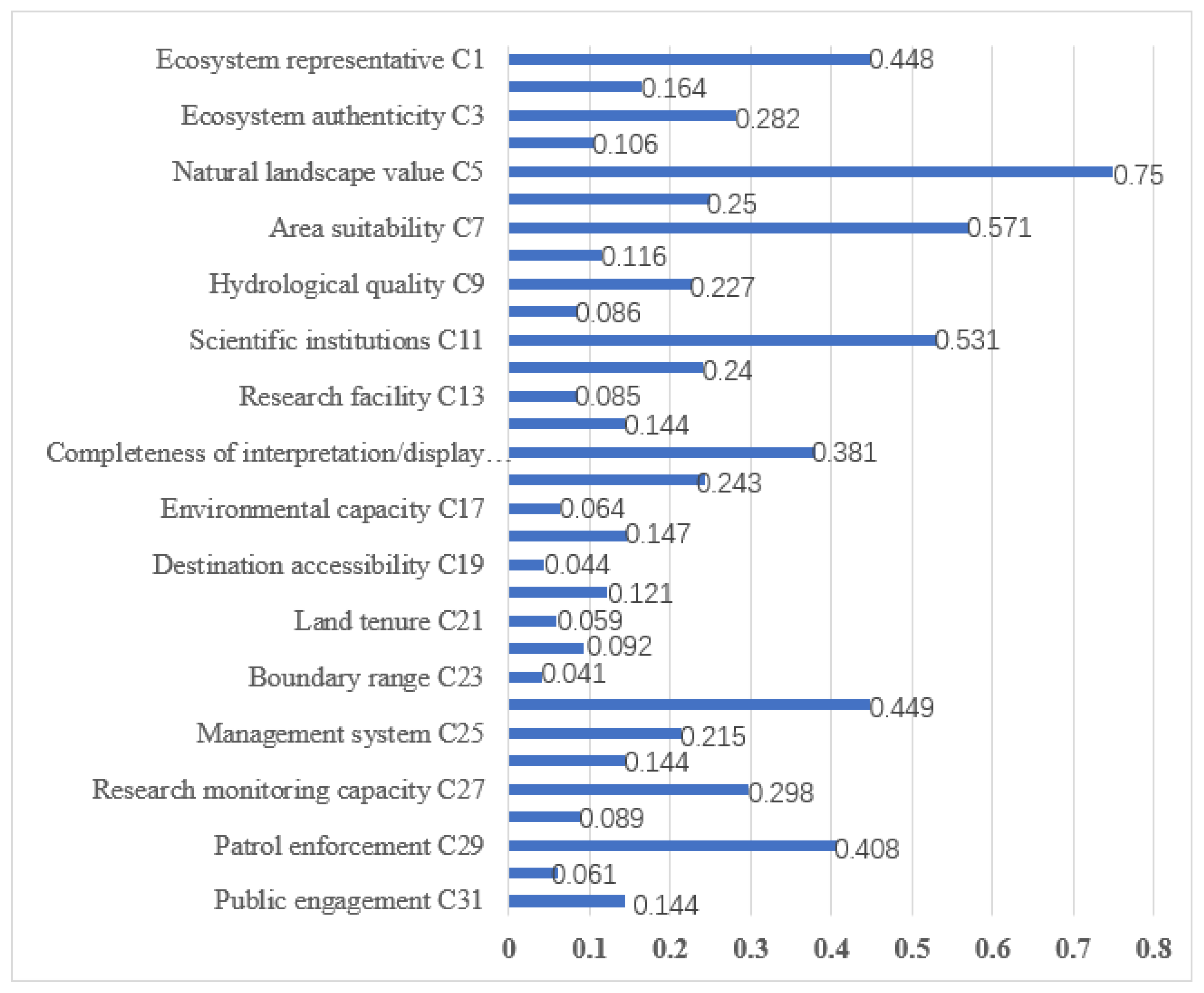
| Respondent | Expertise | Sphere |
|---|---|---|
| R1 | Landscape architecture | Researcher in Zhejiang Agriculture and Forestry University |
| R2 | Landscape architecture | Planner in planning institute |
| R3 | Landscape architecture | A member of staff in the QNPSPA |
| R4 | Forestry | Researcher in Zhejiang Agriculture and Forestry University |
| R5 | Forestry | Researcher in Zhejiang Agriculture and Forestry University |
| R6 | Forestry | A member of staff in the QNPSPA |
| R7 | Tourism management | Researcher in Zhejiang Agriculture and Forestry University |
| R8 | Tourism management | Planner in planning institute |
| R9 | Urban planning | Researcher in Zhejiang Agriculture and Forestry University |
| R10 | Urban planning | Planner in planning institute |
| A1 | A2 | A3 | ... | An | |
|---|---|---|---|---|---|
| A1 | M1/M1 | M1/M2 | M1/M3 | ... | M1/Mn |
| A2 | M2/M1 | M2/M2 | M2M3 | ... | M2/Mn |
| A3 | M3/M1 | M3/M2 | M3/M3 | ... | M3/Mn |
| ... | ... | ... | ... | ... | ... |
| An | Mn/M1 | Mn/M2 | Mn/M3 | 3 | Mn/Mn |
| Scale | Meaning |
|---|---|
| 1 | Two elements are of equal importance compared to each other |
| 3 | The former is slightly more important than the latter when compared to the two elements |
| 5 | The former is significantly more important than the latter when compared to the two elements |
| 7 | The former is more strongly important than the latter when compared to the two elements |
| 9 | The former is of absolute importance than the latter when compared to the two elements |
| 2,4,6,8 | The intermediate value between the two adjacent judgements |
| Reciprocals of above nonzero | If the importance of element i to element j is aij, then the importance of element j to element i is |
| n | 1 | 2 | 3 | 4 | 5 | 6 | 7 | 8 | 9 | 10 |
|---|---|---|---|---|---|---|---|---|---|---|
| R.I. | 0 | 0 | 0.52 | 0.89 | 1.12 | 1.26 | 1.36 | 1.41 | 1.46 | 1.49 |
| Category | Score | Evaluation Level | Description |
|---|---|---|---|
| I | 90–100 | Excellent | Its construction level is very high, and its protection and management are very standard and efficient. |
| II | 80–89 | Very good | Its construction level is high, and its protection and management are standard and efficient. |
| III | 70–79 | Good | Its construction level is intermediate, and its protection and management are basically standard and efficient. |
| IV | 60–69 | Qualified | Its construction level is average, and its protection and management are of ordinary status. |
| V | 0–59 | Failure | Its construction level is low, and its protection and management are of low status. |
| The Objective Level | The Criteria Level | The Indicator Level | The Factor Level |
|---|---|---|---|
| National Park System Pilot Area Evaluation Index System S | Natural resource condition A1 | Ecological condition B1 | Ecosystem representative C1 |
| Ecosystem integrity C2 | |||
| Ecosystem authenticity C3 | |||
| Biodiversity C4 | |||
| Landscape value B2 | Natural landscape value C5 | ||
| Human landscape value C6 | |||
| Environmental attribute B3 | Area suitability C7 | ||
| Soil quality C8 | |||
| Hydrological quality C9 | |||
| Climate quality C10 | |||
| Research, education and recreation function A2 | Research function B4 | Scientific institutions C11 | |
| Research project C12 | |||
| Research facility C13 | |||
| Database building C14 | |||
| Recreation and education function B5 | Completeness of interpretation/display facilities C15 | ||
| Richness of educational display content C16 | |||
| Environmental capacity C17 | |||
| Adequacy of recreational facilities C18 | |||
| Destination accessibility C19 | |||
| Recreation product richness C20 | |||
| Management condition A3 | Management foundation B6 | Land tenure C21 | |
| Natural resources property right C22 | |||
| Boundary range C23 | |||
| Governing institution C24 | |||
| Management System C25 | |||
| Managing financial security C26 | |||
| Management action B7 | Research monitoring capacity C27 | ||
| Management equipment C28 | |||
| Patrol enforcement C29 | |||
| Community co-management C30 | |||
| Public engagement C31 |
| Judgement Matrix | Maximum Eigenvalue λmax | Consistency Index C.I. | Consistency Ratio C.R. | Criteria for C.R. |
|---|---|---|---|---|
| A1.A2.A3 | 3.054 | 0.027 | 0.052 | <0.1 |
| B1.B2.B3 | 3.086 | 0.043 | 0.082 | <0.1 |
| B4.B5 | 2.000 | 0.000 | 0.000 | <0.1 |
| B6.B7 | 2.000 | 0.000 | 0.000 | <0.1 |
| C1.C2.C3.C4 | 4.071 | 0.024 | 0.027 | <0.1 |
| C5.C6 | 2.000 | 0.000 | 0.000 | <0.1 |
| C7.C8.C9.C10 | 4.115 | 0.038 | 0.043 | <0.1 |
| C11.C12.C13.C14 | 4.240 | 0.080 | 0.090 | <0.1 |
| C15.C16.C17.C18.C19.C20 | 6.361 | 0.072 | 0.057 | <0.1 |
| C21.C22.C23.C24.C25.C26 | 6.177 | 0.035 | 0.028 | <0.1 |
| C27.C28.C29.C30.C31 | 5.133 | 0.033 | 0.030 | <0.1 |
| Criteria Level | Weighting | Indicator Level | Weighting | Factor Level | Weighting |
|---|---|---|---|---|---|
| Natural resource condition A1 | 0.493 | Ecological condition B1 | 0.624 | Ecosystem representative C1 | 0.448 |
| Ecosystem Integrity C2 | 0.164 | ||||
| Ecosystem authenticity C3 | 0.282 | ||||
| Biodiversity C4 | 0.106 | ||||
| Landscape value B2 | 0.280 | Natural landscape value C5 | 0.750 | ||
| Human landscape value C6 | 0.250 | ||||
| Environmental attribute B3 | 0.096 | Area suitability C7 | 0.571 | ||
| Soil quality C8 | 0.116 | ||||
| Hydrological quality C9 | 0.227 | ||||
| Climate quality C10 | 0.086 | ||||
| Research, education and recreation function A2 | 0.196 | Research function B4 | 0.250 | Scientific institutions C11 | 0.531 |
| Research project C12 | 0.240 | ||||
| Research facility C13 | 0.085 | ||||
| Database building C14 | 0.144 | ||||
| Recreation and education function B5 | 0.750 | Completeness of interpretation/display facilities C15 | 0.381 | ||
| Richness of educational display C16 | 0.243 | ||||
| Environmental capacity C17 | 0.064 | ||||
| Adequacy of recreational facilities C18 | 0.147 | ||||
| Destination accessibility C19 | 0.044 | ||||
| Recreation product richness C20 | 0.121 | ||||
| Management condition A3 | 0.311 | Management foundation B6 | 0.667 | Land tenure C21 | 0.059 |
| Natural resources property rights C22 | 0.092 | ||||
| Boundary range C23 | 0.041 | ||||
| Governing body C24 | 0.449 | ||||
| Management system C25 | 0.215 | ||||
| Managing financial security C26 | 0.144 | ||||
| Management action B7 | 0.333 | Research monitoring capacity C27 | 0.298 | ||
| Management equipment C28 | 0.089 | ||||
| Patrol enforcement C29 | 0.408 | ||||
| Community co-management C30 | 0.061 | ||||
| Public engagement C31 | 0.144 |
| Evaluation Indicator Level | Score Value |
|---|---|
| Ecological condition B1 | 90.436 |
| Landscape value B2 | 91.250 |
| Environmental attribute B3 | 88.355 |
| Research function B4 | 93.690 |
| Recreation and education function B5 | 89.145 |
| Management foundation B6 | 90.596 |
| Management action B7 | 93.778 |
Publisher’s Note: MDPI stays neutral with regard to jurisdictional claims in published maps and institutional affiliations. |
© 2022 by the authors. Licensee MDPI, Basel, Switzerland. This article is an open access article distributed under the terms and conditions of the Creative Commons Attribution (CC BY) license (https://creativecommons.org/licenses/by/4.0/).
Share and Cite
Zhuang, Q.; Wang, L.; Zheng, G. An Evaluation of National Park System Pilot Area Using the AHP-Delphi Approach: A Case Study of the Qianjiangyuan National Park System Pilot Area, China. Forests 2022, 13, 1162. https://doi.org/10.3390/f13081162
Zhuang Q, Wang L, Zheng G. An Evaluation of National Park System Pilot Area Using the AHP-Delphi Approach: A Case Study of the Qianjiangyuan National Park System Pilot Area, China. Forests. 2022; 13(8):1162. https://doi.org/10.3390/f13081162
Chicago/Turabian StyleZhuang, Qianda, Lin Wang, and Guoquan Zheng. 2022. "An Evaluation of National Park System Pilot Area Using the AHP-Delphi Approach: A Case Study of the Qianjiangyuan National Park System Pilot Area, China" Forests 13, no. 8: 1162. https://doi.org/10.3390/f13081162
APA StyleZhuang, Q., Wang, L., & Zheng, G. (2022). An Evaluation of National Park System Pilot Area Using the AHP-Delphi Approach: A Case Study of the Qianjiangyuan National Park System Pilot Area, China. Forests, 13(8), 1162. https://doi.org/10.3390/f13081162






